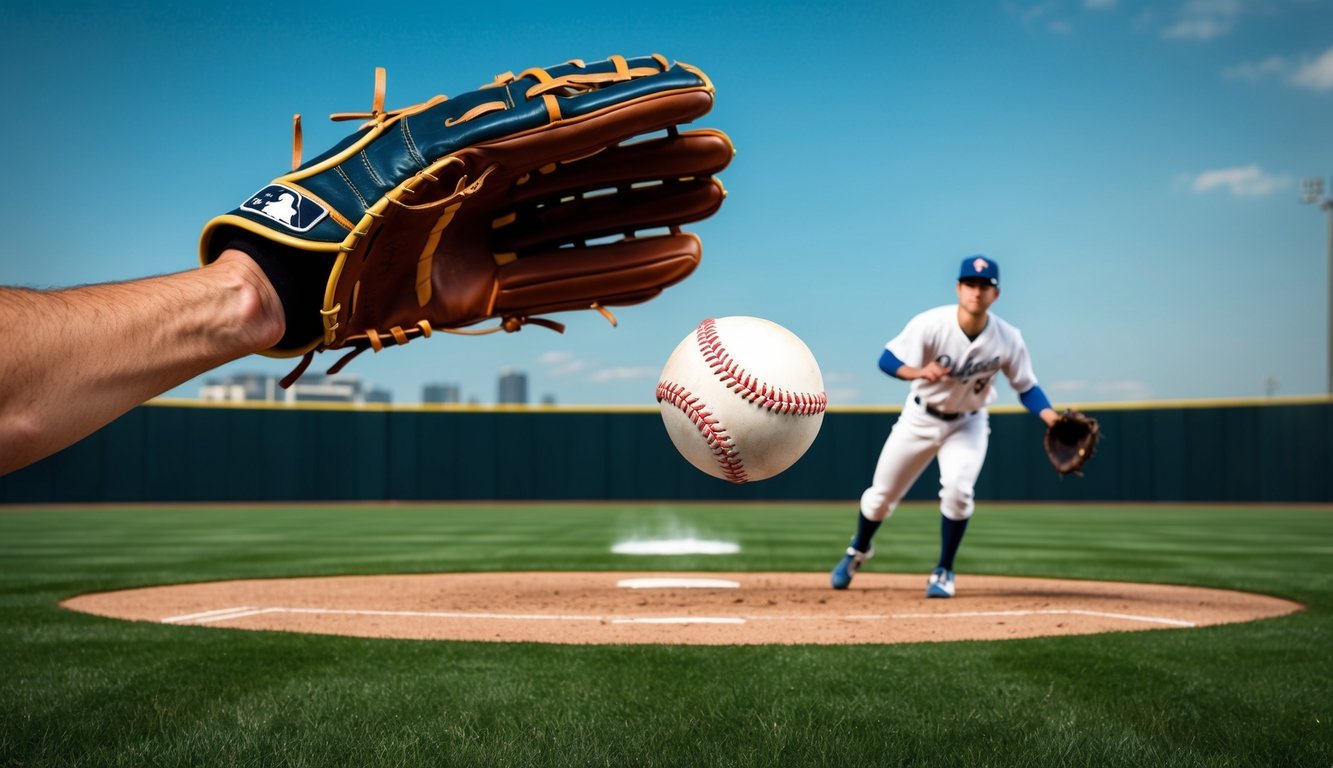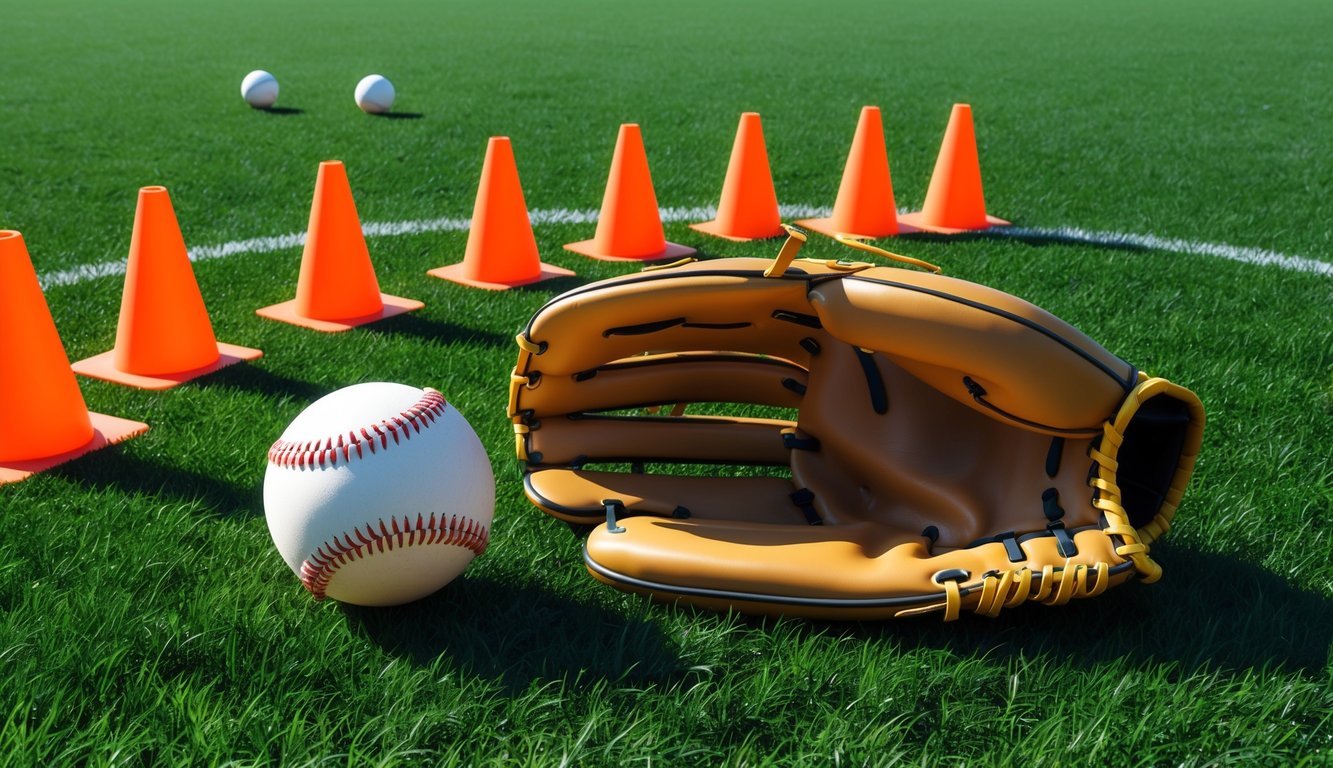Catching a baseball is a fundamental skill that every player needs to master.
Whether you’re a beginner or looking to improve your technique, learning the proper way to catch can make a big difference in your game.
To catch a baseball, you need to use your glove’s pocket and secure the ball with both hands.
Choosing the right glove is crucial for effective catching.
A well-fitted glove should feel comfortable and allow for easy movement.
Once you have the right equipment, focus on your stance and positioning.
Keep your eyes on the ball, move your feet to get in line with its trajectory, and extend your glove to create a target.
Practice is essential to develop good catching habits.
Start with soft tosses and gradually increase the speed and distance as you become more confident.
Remember to always stay alert and ready to react, as catching requires quick reflexes and good hand-eye coordination.
Getting Started with the Basics
Mastering the fundamentals of catching a baseball is essential for players of all levels.
Proper equipment, physical readiness, and correct technique form the foundation for success on the field.
In addition to mastering the fundamentals, players should also pay attention to their gear, as the right equipment can significantly enhance their game.
Utilizing tools like Easton bats performance analysis allows players to fine-tune their swings and improve their overall hitting accuracy.
By combining proper technique with high-quality equipment, athletes can elevate their skills and stand out on the field.
Understanding the Equipment
A well-fitted glove is crucial for catching baseballs effectively.
Choose a glove size appropriate for your age and position.
Youth players typically use smaller gloves, while adults need larger ones.
Break in your new glove by oiling it and playing catch regularly.
Baseball caps protect players from the sun and help track fly balls.
Select a comfortable, breathable hat that fits snugly.
Protective gear like cups and chest protectors are important for catchers and other positions prone to hard hits.
The Role of Age and Physical Fitness
Age and physical fitness play significant roles in catching ability.
Young players often start with softer balls and gradually progress to regulation baseballs as they develop hand-eye coordination and strength.
Adults should maintain overall fitness to improve reflexes and agility.
Regular cardiovascular exercise and hand-eye coordination drills can enhance catching skills.
Beginners of any age should start with slow, short-distance throws to build confidence before attempting more challenging catches.
Fundamentals of Stance and Glove Positioning
A proper catching stance provides balance and readiness.
Stand with feet shoulder-width apart, knees slightly bent, and weight on the balls of your feet.
This athletic position allows for quick movements in any direction.
Hold the glove out in front of your body, fingers pointing up for high throws or to the side for low ones.
Keep your throwing hand near the glove to secure the ball after catching.
Practice moving to the ball rather than reaching.
Step towards the throw, aligning your body behind the glove to create a solid catching platform.
Mastering the Catch
Catching a baseball demands precise technique, unwavering focus, and fluid body control.
Honing these skills transforms fielders into defensive assets for their teams.
Eyes on the Ball: Focus and Concentration
Keeping eyes locked on the ball is crucial for successful catches.
As the ball leaves the bat or pitcher’s hand, track its trajectory carefully.
Don’t blink or look away, even for a split second.
Anticipate the ball’s path and prepare your body to move accordingly.
Practice helps develop this skill.
Try catching balls from different heights and angles to improve tracking ability.
Stay alert throughout the play.
Distractions can lead to missed catches, so tune out crowd noise and maintain laser-like focus on the ball.
Hand and Glove Coordination
Proper hand-glove coordination is essential for secure catches.
Position your glove with the pocket facing the ball.
Keep your throwing hand close to the glove for added protection and control.
As the ball approaches, move your glove smoothly to meet it.
Avoid stabbing or jerky motions.
Instead, use a soft, controlled movement to absorb the ball’s impact.
Practice the “alligator catch” technique.
Close your glove like an alligator’s jaws, trapping the ball inside.
This method helps prevent fumbles and dropped catches.
Positioning and Footwork Techniques
Good positioning sets the foundation for successful catches.
Stay light on your feet, ready to move in any direction.
Keep your weight on the balls of your feet for quick reactions.
Take small, quick steps to adjust your position as the ball travels.
This helps maintain balance and improves catch accuracy.
For fly balls, use the crossover step to cover ground quickly.
For ground balls, use the drop step to get low and field cleanly.
Practice these footwork patterns regularly to make them second nature.
Advanced Skills Development

Mastering advanced catching techniques elevates a player’s defensive capabilities.
These skills enhance performance across different positions and game situations.
Catching for Different Positions
Outfielders need to excel at over-the-shoulder catches and judging fly balls.
They practice tracking high pop-ups and line drives.
Infielders focus on quick reflexes for ground balls and line drives.
Shortstops and second basemen work on double-play transfers.
Third basemen hone their reactions to hard-hit balls down the line.
First basemen practice scooping low throws.
Catchers have unique challenges.
They drill on framing pitches, blocking wild throws, and fielding bunts.
Quick transitions from catching to throwing are crucial for stopping base stealers.
Diving and Dynamic Catches
Spectacular diving catches can change the momentum of a game.
Players start by learning proper diving technique on soft surfaces.
They progress to grass drills, diving for rolled balls.
Advanced drills involve reacting to hit balls, emphasizing body control and safe landings.
Players practice timing their dives and extending fully to snag difficult catches.
Sliding catches are another key skill.
Outfielders work on feet-first and head-first slides to catch low line drives.
Infielders practice sliding stops to field ground balls up the middle.
Fine-Tuning Catching Technique
Perfecting the fundamentals is crucial for consistent performance.
Players focus on maintaining a proper athletic stance, ready to move in any direction.
Hand positioning is critical.
Catchers practice “soft hands” to absorb the ball’s impact.
Outfielders work on catching the ball above eye level to improve their throwing transition.
Footwork drills enhance a player’s ability to get in position quickly.
This includes crossover steps for outfielders and quick lateral movements for infielders.
Eye training exercises improve depth perception and ball tracking.
Players use colored balls and variable pitching machines to sharpen their visual skills.
Practical Drills and Practice Routines

Effective catching skills come from consistent practice and focused drills.
Players can improve their technique, reaction time, and confidence through regular training sessions.
Solo and Team Drills
Pop-up drills help catchers track high balls.
Players can practice alone by tossing balls up and catching them, or with a partner who throws pop-ups from various distances.
Ground ball drills are crucial for fielders.
Rolling balls to teammates helps simulate game situations.
Players should practice fielding from different angles and speeds.
Wall ball is an excellent solo drill.
Throwing against a wall and catching the rebound improves hand-eye coordination and reflexes.
Vary the force and angle of throws to challenge yourself.
For team practices, run relay drills.
Players form a line and quickly catch and throw to the next person.
This improves transfer speed and accuracy under pressure.
Game Situation Practice
Set up bases and run through common game scenarios.
Practice fielding bunts, throwing out base stealers, and backing up throws to different bases.
Simulate double plays with infielders.
Catchers should practice quick transfers and accurate throws to second base.
Create pressure situations by adding time limits or competition elements to drills.
This helps players stay focused and perform under stress.
Practice communication drills.
Catchers should call out pop-ups and coordinate with infielders on shallow hits.
Clear, loud calls are essential in noisy game environments.
Coaching Tips for Improvement
Coaches should emphasize proper form over speed initially.
Ensure players use two hands when possible and position their bodies correctly behind the ball.
Use video analysis to highlight areas for improvement.
Slow-motion replays can reveal subtle technique issues that players might not notice during practice.
Incorporate agility drills to improve footwork.
Quick feet are crucial for catchers to get into position for errant pitches or throws.
Encourage players to visualize successful catches.
Mental preparation can boost confidence and performance on the field.
Set achievable goals for each practice session.
Tracking progress motivates players and helps identify areas needing more focus.
Understanding and Leveraging Game Dynamics

Catching a baseball involves more than just physical skills.
It requires a deep understanding of game dynamics and the ability to adapt to various situations on the field.
Reading the Play and Anticipation
Successful catchers excel at reading the play and anticipating what’s coming next.
They study batters’ tendencies and work closely with pitchers to predict likely outcomes.
This knowledge helps them position themselves correctly and react quickly.
Catchers must be alert to potential steals, bunts, and hit-and-run plays.
They watch base runners closely, noting their leads and any suspicious movements.
By anticipating these plays, catchers can signal pitchers for pickoff attempts or call for pitchouts.
Reading the game also involves understanding how different pitches behave.
Catchers adjust their stance and glove position based on the expected pitch type and location.
This preparation allows for smoother catches and better framing.
Communication and Teamwork
Effective communication is crucial for catchers.
They act as the team’s on-field captains, coordinating defensive strategies and relaying signals from the dugout.
Catchers use hand signals to call pitches and defensive plays.
They must ensure these signals are clear to teammates but hidden from opponents.
Regular practice with pitchers helps build a strong rapport and understanding of each other’s preferences.
During games, catchers often visit the mound to discuss strategy or calm nervous pitchers.
They also communicate with infielders about defensive positioning and potential plays.
Clear, concise communication helps prevent errors and keeps the team working as a cohesive unit.
Playing Smart: Minimizing Errors
Smart catchers focus on minimizing errors to maintain the team’s defensive edge.
They practice proper footwork and transfer techniques to make quick, accurate throws to bases.
This skill is essential for catching potential base stealers.
Blocking wild pitches is another critical skill.
Catchers learn to drop to their knees and use their body to keep errant pitches in front of them.
This technique prevents passed balls and limits advancing runners.
Catchers must also be adept at fielding bunts and pop-ups in their vicinity.
They practice quick reflexes and coordinate with infielders to avoid collisions.
By playing smart and minimizing mistakes, catchers significantly contribute to their team’s success.
